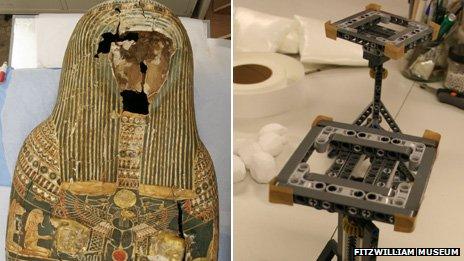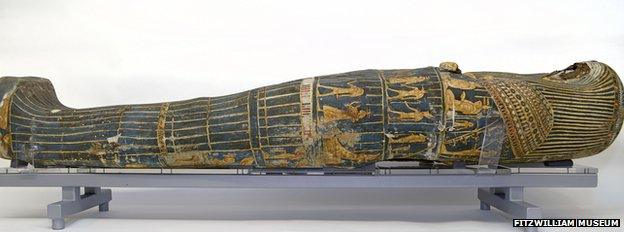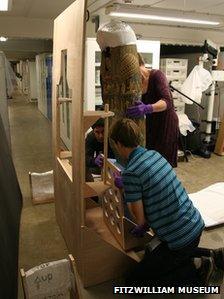Cambridge University Egyptian mummy restored with Lego
- Published

The Hor cartonnage was restored using supports made from Lego components
An Egyptian mummy case stored in a museum basement for about 50 years has been restored with the help of Lego.
Cambridge University engineering student David Knowles, 22, used the components to assist conservators at the city's Fitzwilliam Museum.
The Hor mummy case, dating from the 10th Century BC, had collapsed and Mr Knowles designed internal Lego frames to support it after conservation work.
A spokesman described his design as "crucial" to the project's success.
The cartonnage mummy case - made of layers of plaster, linen and glue - was found in a temple at Ramesseum in Thebes, Luxor, in 1896.
The gilded wooden face had been torn out by robbers and the mummy removed.
'Instrument of torture'
"It came to the museum pretty much after the excavation, and was certainly displayed, but then its history is a bit mysterious," said Julie Dawson, senior assistant keeper of conservation.
At some point it had been exposed to damp conditions and had sagged around the chest and face resulting in cracking and instability in the painted decoration.
There had been some attempts at repair and restoration, most likely in the cartonnage's early years in the Museum.
However, conservators at the Fitzwilliam decided that proper restoration required the services not just of an expert in cartonnage material, but a structural engineer to advise on the stress points of the object, and how it could safely be handled.
Mr Knowles volunteered to work with conservator Sophie Rowe as part of his final year project.
"I love history and engineering, and this was a great way of combining the two," he said.
The museum needed a structure that would safely hold the cartonnage during conservation, and a way of supporting the chest area afterwards.
"David made something that looks like an instrument of torture with a sort of helmet, and shoulder pads made of mesh they use in hospitals for making casts.
"This could be shaped with heat so we could get a very precise fit and precise support," Ms Dawson said.
'Flash of inspiration'
"The case could then lie face downwards so Sophie could work through the back, very slowly."

The restored mummy case is now on permanent display in the museum
The delicate operation involved gradually humidifying the case from the inside before bringing the collapsed chest back up into place.
"We then needed to support that somehow, and David said he could make some small shapes from Lego that would go inside the case," Ms Dawson said.
"He created padded platforms - one at the top and one at the bottom - and between there's a screwthread mechanism so we can alter the height.
"The top platform can swivel which means it can adapt itself to the shape of a cartonnage."
Mr Knowles, who graduated this year, said: "Lego was one of my favourite toys as a child and we use it for lots of things in the engineering department."

David Knowles (front) with his "instrument of torture"
He said the support platform took about eight weeks to design and build, but described his Lego platforms as "a couple of flashes of inspiration".
Project supervisor, Simon Guest, a reader in structural mechanics in the engineering department, said: "This is such a good outreach activity for us to show that engineering is not just about metal-bashing and sums.
"It's also about interesting objects and doing things that help the public.
"It even inspired my 11-year-old son, Daniel, who lent his Lego ideas book to David in case it would help him."
Ms Dawson said: "David assured us Lego was very light and wouldn't deteriorate over time, which was very important to us if we were going to put something inside an ancient object that was going to be there permanently.
"We're delighted it's restored. It's considered to be an extremely important object of its type.
"Although it still looks quite damaged it's a beautiful piece, so to be able to bring such a major object out after so many years living sadly in the basement is a really great result for us," she added.
The Hor cartonnage mummy case is now on permanent display at the Fitzwilliam Museum in Cambridge.
- Published18 July 2012
- Published18 July 2012
- Published29 June 2012
- Published10 February 2012
- Published27 January 2012